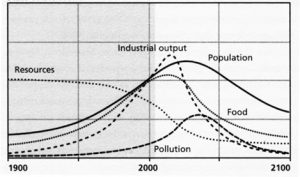
In recent years, growth has become a household term in India. In the pursuit of global status and prestige, we all have thrown ourselves into the furnace of growth. It seems this is the only parameter that matters.
- Are we not missing a crucial point here?
- The point is how sustainable is our present model?
- How long can we sustain this growth?
The industrial revolution gave birth to the concept of a modern free-market economy that started at the expense of natural resources. Since then, there has been no looking back. For the last 200 years, we have exploited natural resources to foster economic growth. This model of growth performed like a miracle till the late 90’s as natural resources were abundant to sustain it. However, the depletion in the resources due to ever-increasing demand has questioned the sustainability of this model in the last two or three decades.
(Figure-1).

Fig 1: Variation of industrial output with natural resources, population, and food statistics.
(Source: https://www.fresheconomicthinking.com/2010/10/no-limits-to-economic-growth.html)
Since civil engineers work in close association with civil society, sustainability of life and natural resources has been the most important concern for them to address.
Alarming shortage of Water: A threat to the human civilization competing for economic growth.

(Pic. Credit: Elijah Hiett – UNSPLASH)
Water is probably the most important natural resource to sustain life. Though water makes up about 71% of the planet’s surface, only 3% of that water is potable. Around 2.5% of that 3% freshwater has disappeared due to depleting sources like glaciers, water vapors in the atmosphere, and moisture content in the soil. Similarly, some of the water bodies are highly polluted or situated at a far greater depth therefore not available for use. Finally, we are left out with only 0.05% of the earth’s total water as a source of useable water supply. The amount is equivalent to 0.003 liters (one-half teaspoon) given the water supply of the world is 100 liters. Furthermore, the quality and quantity distribution of freshwater is extremely heterogeneous. That means we don’t have sufficient water when we need it and where we need it. The uncontrolled exploitation of water for agricultural, industrial, and domestic use has further depleted its quantity and deteriorated its quality.
As Civil Engineers in the 21st century, it is our responsibility to model, predict and implement a suitable approach for sustainable development without overexploiting the available natural water resources. However, any model dealing with the consumption of natural resources cannot be sustainable if it does not account for the alteration in the socio-economic condition. For example, Lake Mead was built on the Colorado River in 1930 as a water source for California, Arizona, and Nevada. The population of Las Vegas was projected as 400,000 by the end of 2000. However, the population of Las Vegas became around four times more of the estimated population. This unexpected population growth was enabled by an increased water supply from Lake Mead. In the 2000s, in response to severe droughts, the city got close to water shortage. Similarly, In Athens, the Mornos Reservoir overflow of 1985 led to a new law in 1987 which declared water as a “natural gift” and “undeniable right” for every citizen. As a result of that, there was unrestricted use of water. Two years later, the area faced a severe drought which pushed the entire system to its limits and government responses were slow due to lack of conservation measures undertaken.
These two incidents clarify the importance of understanding the alteration in the socio-economic condition of a region and its impact on policymaking. Therefore, it is of utmost importance that we need to come up with much more robust models when dealing with water resources management or for that matter any natural resources management which can also account for the socio-economic alteration. Our inability to understand, integrate and balance this interrelation between natural resources and society can result in an economic and social collapse towards the late 21st. (Meadows et al., 1972).
Dr. Ashes Banerjee,
Assistant Professor
Alliance College of Engineering & Design
References:
Meadows, D. H., Randers, J., & Meadows, D. L. (2013). The Limits to Growth (1972) (pp. 101-116). Yale University Press.
